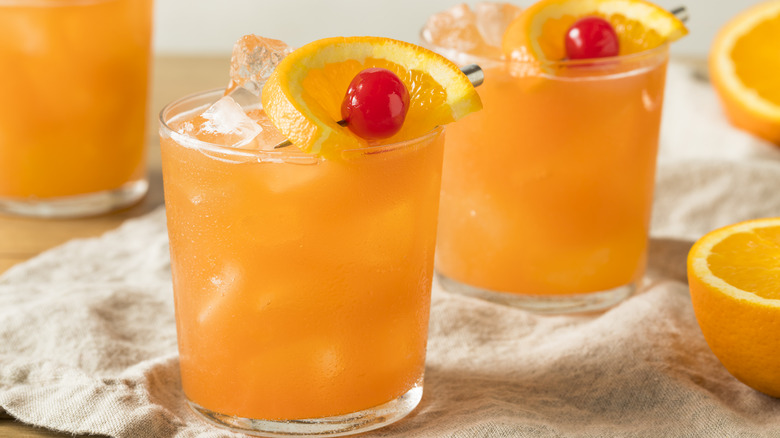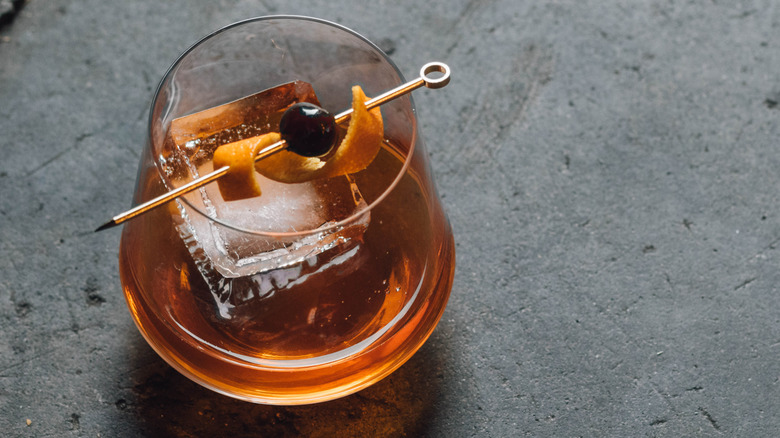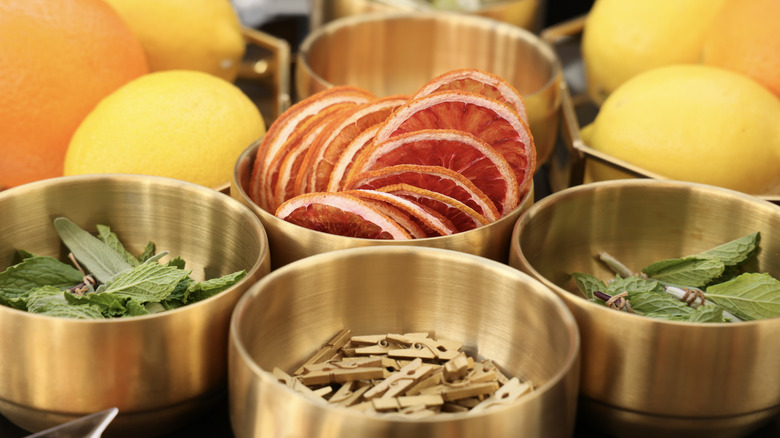What Is A Flag Garnish For Cocktails?
It may seem unnecessary — an afterthought, since it's the last thing done — but garnishing cocktails enhances your drinking experience in several ways. The most apparent is visual; garnishes add color and texture to the drink and can be quite enticing, even when you're making it for yourself. Additionally, a garnish adds an aroma that allows you to breathe in the cocktail before it touches your lips. Then there's taste. Whether sweet, salty, bitter, herbaceous, or sour, the garnish can add flavor to your drink and, in some cases, provide a snack to nibble on.
While garnishes can be pretty elaborate at swanky cocktail bars, they don't need to be complex to improve the drink. A single ingredient, like a long strip of cucumber, can transform a classic Prohibition cocktail into something modern. Instead of mindlessly dropping a maraschino cherry into your next whiskey cocktail, try a flag garnish to dress it up.
To make a flag garnish, you'll need a cocktail pick, a citrus slice cut in half (such as an orange), and a cherry without a pit, preferably a Luxardo maraschino cherry. Pierce the pith of the orange slice on the left side with the pick. Then, skewer a cherry through its center and pierce the orange again on the right side, so it appears to be hugging the cherry. Balance the fruit flag on the rim of a cocktail glass and enjoy.
Tips for making a flag garnish
The cocktail garnish can play a role in your party's theme by coordinating with the colors. Consider the composition of the drink. Rather than adding a red garnish to a red cocktail, use a contrasting color like orange or green to make it pop. Pale cocktails like the Tom Collins look more appealing with a colorful fruit flag made with a lemon slice and cherry. Lowball glasses and coupes, on the other hand, are traditionally wider than highballs, so ensure the cocktail pick is at least one inch longer than the diameter of the glass to balance the flag on the rim. Try to pierce the fruit through the pith so it doesn't tear.
Citrus flags can be made with grapefruits, lemons, limes, tangerines, and more. Remove any seeds before adding the garnish to prevent them from ending up in the drink. If you want the essence but not the juice, you can use long strips of citrus peel, removing the fruit's outer layer with a sharp Y-peeler for a sophisticated variation. For a smoky garnish, burn or roast the citrus.
Non-alcoholic cocktails or mocktails shouldn't be left out of the party. Treat guests who don't drink alcohol, including children, to a fancy Shirley Temple or shrub to enhance their experience, too.
Flag garnish variations
A flag garnish should be customized to the beverage, varying the citrus, herbs, and produce used. The garnish should complement the drink's flavor and offer a clue as to what's inside. Maraschino cherries are appropriate in bourbon or whiskey drinks, as well as cocktails like a sour cherry gin sling. However, if a cherry isn't suitable, consider using a different round fruit for the presentation, such as berries, grapes, or melon balls.
For green garnishes, think of grapes, honeydew melon, or gooseberries. For something blue or purple-hued, consider blueberries, blackberries, figs, or black currants. And if you want to vary the red in your flag, ripe strawberries, raspberries, cranberries, or grapes are good options. A cosmopolitan garnished with a lime and cranberry flag would be lovely to receive, especially during the holidays when the seasonal fruit's color palette works well.
Flags can also be made with vegetables and herbs. A lemon wheel wrapped around a blue cheese-stuffed olive would complement an OG martini. If you're serving a spicy margarita, try adding a small chili pepper wrapped around a cucumber strip to signal the drink's heat to your guests.



